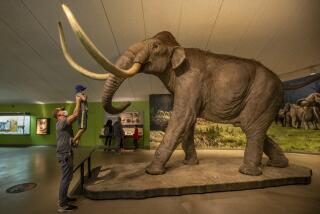Scientists conclude that global warming never went on ‘hiatus’
- Share via
A fresh look at the way sea temperatures are measured has led government scientists to make a surprising claim: The puzzling apparent hiatus in global surface warming never really happened.
In a study published Thursday in the prestigious journal Science, researchers from the National Oceanic and Atmospheric Administration wrote that Earth’s global average surface temperature had climbed 0.2 of a degree Fahrenheit each decade since 1950, without interruption, due to the heat-trapping effects of greenhouse gases.
That conclusion seemingly negated an awkward piece of evidence in the debate over whether human activity is indeed warming the planet.
Mainstream scientists have struggled to explain to the public how climate change can be getting worse if the warming of the planet’s surface slowed at the turn of the century. Their various theories have chalked it up to dust and ash blasted into the sky by volcanic eruptions, a rare period of calm in the solar cycle, and heat absorption by the Pacific Ocean and other waters.
Meanwhile, climate change skeptics have embraced the hiatus as evidence that climatologists have greatly miscalculated the warming effects of fossil-fuel emissions.
The new findings — which are based on measurements from thousands of land stations, ships and buoys at sea going back to 1880 — drew criticism from people on both sides of the rancorous debate over man-made climate change.
“I don’t find this analysis at all convincing,” said Judith Curry, a climatologist at Georgia Tech who argues that natural variability in climate cycles dominates the impact of industrial emissions and other human actions. “While I’m sure this latest analysis from NOAA will be regarded as politically useful for the Obama administration, I don’t regard it as a particularly useful contribution to our scientific understanding of what is going on.”
Researchers representing the scientific mainstream also rejected the idea that global surface temperatures never stopped rising.
“It’s always good to go back and look at the data as carefully as possible and make sure it’s calibrated correctly,” said William Patzert, a climatologist at NASA’s Jet Propulsion Laboratory in La Cañada Flintridge. “But the hiatus is history and it was real.”
The idea that the ominous rise in Earth’s average surface temperature had begun to slow in 1998 was acknowledged by the Intergovernmental Panel on Climate Change, or IPCC, in 2013. The panel determined that from 1998 to 2012, the warming trend was just one-third to one-half what the trend was from 1951 to 2012.
Acknowledgment of the hiatus, or pause, prompted a flurry of research into where all of the planet’s “missing” heat could be hiding.
In the study, the NOAA researchers argue that long-standing problems with the way temperatures are measured have masked years of sea surface warming. Once those problems are corrected for, “this hiatus or slowdown simply vanishes,” said lead study author Thomas Karl, director of NOAA’s National Climatic Data Center in Asheville, N.C.
The information that led Karl and his colleagues to their controversial conclusion was contained in the new Extended Reconstructed Sea Surface Temperature data set, which helps scientists monitor and describe the effects of climate change.
Karl said the new data were the result of some recent revelations on the part of climatologists.
Although researchers have long known that sea surface temperatures measured by autonomous buoys run cooler than temperatures measured by ships, they have failed to account for this as they expanded their use of buoy readings over the last two decades, the study authors argued.
This, combined with the fact that ships now sample a smaller area of the world’s oceans, have skewed the data toward cooler temperatures, they say.
Also, though it had long been assumed that ships measured seawater temperature with engine intake thermometers — an innovation that began after World War II — that is not the case, Karl said. Instead, some ships still scoop up seawater in canvas or metal buckets.
“The buckets, when you pull them up, tend to evaporate their water, and if they’re canvas there’s even more evaporation,” Karl said. “By the time people stick a thermistor in the bucket to measure temperature, it’s already slightly cool.”
To correct for the discrepancy between bucket and engine measurements, Karl and his colleagues used nighttime air temperature readings taken from the deck of the ship to calibrate the readings.
The researchers also argued that the IPCC’s decision to use 1998 as a start of the hiatus skewed the results. That year marked an extreme El Niño, a period of unusually warm sea surface temperatures.
“If you start a short-time series on an anomalous value, you tend to get an anomalous trend,” Karl said.
Since the IPCC acknowledged a warming slowdown in 2013, global average temperatures have resumed their upward trend. Researchers say 2014 was among the warmest years on record, and 2015 may be even hotter.
Karl’s team and other scientists have noted that, ironically, a large swath of the industrialized world has enjoyed a period of land surface cooling since the start of the 21st century. This cooling has occurred in the mid-latitudes of the Northern Hemisphere, including North America, Europe and much of Asia, but the global average continues to rise.
A growing number of climate scientists have argued that this phenomenon, as well as other hiatus effects, are evidence of a poorly understood pattern of wind, ocean current and temperature variations that have far-reaching effects on global climate. They say the oceans have absorbed heat energy from the sun, causing Arctic ice to melt and sea levels to rise.
“One way to think about it is that global warming continued, but the oceans just juggled a bit of heat around and made the surface seem cooler for a while,” said Joshua Willis, another climate scientist at JPL.
One of these patterns, called the Pacific Decadal Oscillation, has a warm phase and a cool phase, each of which can last many years. The current cool phase may account for the hiatus noted by the IPCC and others, Willis said.
Karl said he had been challenged frequently by fellow scientists but stood by the study’s conclusion. He said he was often asked whether he was denying the cooling effects of volcanic aerosols, a cyclical dip in solar energy or the heat-absorbing effects of the ocean.
“All of those factors are real,” Karl said. “If those factors had not occurred, the warming rate would have been even greater. … If anything we may still be underestimating the trend.”







